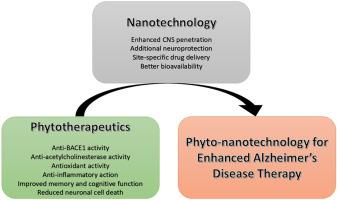植物纳米技术:一种治疗阿尔茨海默病的新型有益策略。
IF 4
3区 医学
Q2 BIOCHEMISTRY & MOLECULAR BIOLOGY
引用次数: 0
摘要
阿尔茨海默病是一种神经退行性疾病,其特征是老年患者的认知功能缓慢而逐渐地退化。它的发生是由于大脑神经元的恶化,表现为记忆力减退、情绪不稳定,甚至死亡。淀粉样β蛋白和神经纤维缠结(tau蛋白的典型形式)的聚集是这种疾病的主要原因。植物成分经常被用于治疗阿尔茨海默病。这些天然化合物通过不同的分子机制来治疗这种疾病。然而,由于血脑屏障渗透性差、脱靶效应、生物利用度低等原因,它们在阿尔茨海默病治疗中的潜力可能受到限制。近来,纳米技术在克服这些挑战方面越来越有吸引力。本文重点介绍了治疗阿尔茨海默病的潜在植物成分及其相关局限性。此外,文章还重点介绍了各种纳米制剂策略,以有效穿透血脑屏障、避免副作用、提高生物利用度和治疗阿尔茨海默病的靶向特异性。纳米技术与植物提取化合物的结合有望彻底改变阿尔茨海默病的治疗格局。本文章由计算机程序翻译,如有差异,请以英文原文为准。

Phyto-nanotechnology: A novel beneficial strategy for Alzheimer's disease therapy
Alzheimer's disease, a neurodegenerative condition, is characterized by the slow and progressive deterioration of the cognitive functions of geriatric patients. It occurs due to exacerbation of neurons in the brain, indicated by loss of memory, mood instability, and even death. The aggregation of amyloid β protein and neurofibrillary tangles-atypical forms of tau protein is the major cause of this disease. Phytoconstituents have been frequently employed in treating Alzheimer's disease. These natural compounds act through different molecular mechanisms to treat the disease. However, their potential in Alzheimer's disease therapy may be limited due to poor blood-brain barrier permeability, off-target effects, low bioavailability, etc. In recent times, nanotechnology has gained attraction to overcome these challenges. This article focuses on the potential phytoconstituents for Alzheimer's disease treatment and the associated limitations. Moreover, it highlights various nanoformulation strategies employed to penetrate the blood-brain barrier effectively, avoid side effects, improve bioavailability, and target specificity in treating Alzheimer's disease. The integration of nanotechnology with plant-derived compounds has the potential to revolutionize the therapeutic landscape for Alzheimer's disease.
求助全文
通过发布文献求助,成功后即可免费获取论文全文。
去求助
来源期刊

Neurochemistry international
医学-神经科学
CiteScore
8.40
自引率
2.40%
发文量
128
审稿时长
37 days
期刊介绍:
Neurochemistry International is devoted to the rapid publication of outstanding original articles and timely reviews in neurochemistry. Manuscripts on a broad range of topics will be considered, including molecular and cellular neurochemistry, neuropharmacology and genetic aspects of CNS function, neuroimmunology, metabolism as well as the neurochemistry of neurological and psychiatric disorders of the CNS.
 求助内容:
求助内容: 应助结果提醒方式:
应助结果提醒方式:


